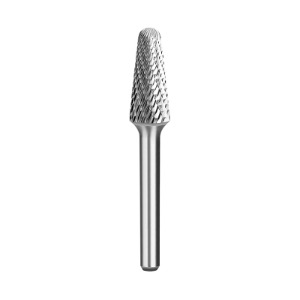Versatility of Carbide Rotary Burs
Carbide Rotary Burs are widely used in industrial and precision machining due to their good hardness, wear resistance, and cutting efficiency. The performance of these burs, however, varies significantly depending on the material being processed. Understanding how they behave when cutting steel, aluminum, alloys, or plastics is essential for optimizing tool selection, cutting parameters, and operational efficiency.

Performance on Steel
- Cutting Efficiency: Steel, being hard and dense, presents high resistance to cutting. Carbide Rotary Burs maintain sharpness and provide efficient material removal when used at appropriate rotational speeds and feed rates.
- Heat Generation: Cutting steel generates significant heat due to friction. Proper use of coolants or lubricants is necessary to prevent overheating, which can reduce bur life and affect surface quality.
- Wear Resistance: The hardness of steel accelerates abrasive wear on the bur’s cutting edges. Choosing burs with optimized tooth geometry and high-quality carbide material helps maintain performance over longer periods.
Performance on Aluminum
- Cutting Speed: Aluminum is softer and less dense than steel, allowing higher rotational speeds and faster feed rates. Carbide Rotary Burs can remove material more quickly without excessive wear.
- Chip Formation: Aluminum tends to stick to cutting edges, creating burrs or clogging the teeth. Proper bur tooth design, sometimes with polished surfaces, prevents material adhesion and ensures smooth operation.
- Surface Finish: With controlled feed and speed, aluminum cutting produces smooth surfaces, as carbide burs maintain consistent sharpness and reduce vibration.
Performance on Alloys
- Material Variation: Alloys present a wide range of hardness and thermal conductivity characteristics. Carbide Rotary Burs are particularly effective for harder alloys due to their good wear resistance and rigidity.
- Temperature Management: Some alloys are sensitive to heat and can soften or discolor during cutting. Using proper coolant and adjusting cutting speed ensures the burs maintain sharpness while protecting the material.
- Precision Cutting: Alloy components often require dimensional accuracy. Carbide burs, combined with stable tool holders and correct feed rates, help achieve precise cuts without chipping or distortion.
Performance on Plastics
- Low Resistance: Plastics offer minimal cutting resistance compared to metals. Carbide Rotary Burs excel in producing clean, detailed cuts without cracking or melting the material when appropriate speeds are selected.
- Reduced Heat Concerns: Plastics generate less heat, but improper speed can still cause softening or surface melting. Selecting the correct rotational speed and tooth configuration ensures quality finishing.
- Versatility: Burs can be used for shaping, engraving, and deburring plastic parts, taking advantage of their precision and sharp cutting edges.
Operational Considerations
- Speed and Feed Adjustment: Suitable performance requires adjusting rotational speed and feed rate according to the material. Steel requires slower feeds, aluminum faster, and plastics careful balance to avoid melting.
- Coolant and Lubrication: Metals benefit from cooling fluids to dissipate heat and prolong bur life, while plastics often require minimal or no coolant.
- Bur Geometry Selection: Different materials may require specific tooth patterns, flute designs, or coatings to optimize cutting efficiency and surface finish.
Carbide Rotary Burs demonstrate versatile performance across steel, aluminum, alloys, and plastics when proper operational parameters are applied. Hard materials like steel demand precise speed control and cooling, softer metals like aluminum benefit from faster feeds and anti-adhesion designs, alloys require careful heat management, and plastics need controlled speeds to prevent melting. By understanding these material-specific requirements, operators and manufacturers can improve cutting efficiency, prolong tool life, and achieve consistent precision in diverse applications, making Carbide Rotary Burs a highly reliable solution for industrial and precision machining tasks
